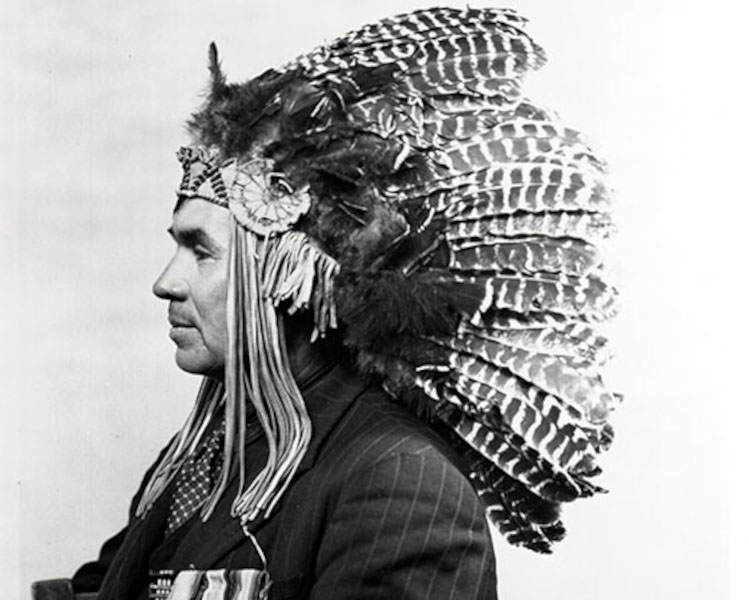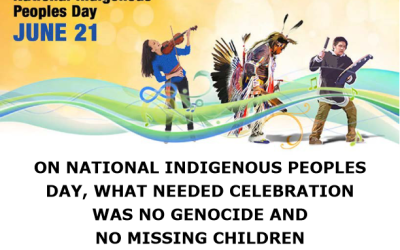From the earliest times, European newcomers and Indigenous people in what is now Canada have worked together. Indigenous people showed early Europeans how to survive in our harsh northern climate. They assisted militarily in the battles between the factions claiming sovereignty. They helped prevent U.S. expansion into what was to become Canadian territory.
They were essential early players in the trade and commerce that built Canada. Not everyone realizes that more than 4,000 Indigenous Canadians voluntarily served this country in the First World War. In just one example, Francis Pegahmagabow (“Peggy”), distinguished himself in several bloody battles. In one of them, he crawled through the Passchendaele battlefield’s mud and water to keep his comrades informed of the locations of enemy units. For this bravery, he received a bar to his Military Medal, which he had previously earned at Ypres, Festubert and Givenchy. Nation-building is a complex process. Plenty of good has come from the relationships that developed in the creation of one of the finest countries in the world.
But we must also acknowledge that the path has not always been smooth for everyone. Prime Minister Stephen Harper attempted to address this, in 2008, when he acknowledged there were issues with the Indian Residential Schools. What Canadians hoped would be the beginning of a more respectful relationship – a better understanding, a better deal for Indigenous people – has turned out to be quite the opposite. Rather than healing, we have seen an almost daily re-opening and deepening of wounds the Prime Minister’s apology was intended to address.
Indigenous leaders at the highest levels and their activist/journalist supporters have used Harper’s sincere expression of regret to exact many more pounds of flesh. Having acknowledged their roles, the federal government and the churches involved in the schools have since been subjected to more and more indictments, including the indictment Parliament inflicted upon Canadians on October 27, 2022 when – without evidence or debate – members of the House of Commons voted to convict Canada of genocide.
The government and the churches are now accepting full responsibility for “what happened”, to use the words of the resolution moved and passed in the House of Commons. But what of the participation of Indigenous leaders and the ordinary Indigenous people involved, those who helped build the schools, those who worked at them, those who sent their children to them?
We hear little or nothing of their participation. But without their co-operation and involvement, many Indigenous children might have received no education at all – unless it was obtained at Indian day schools or public schools. Even so, a third of the Indigenous children of the day received no formal education at all – not at residential schools, Indian day schools or public schools.
In fact, various chiefs across Canada were instrumental in having residential and day schools built and operated. Many Indigenous folks were actively involved in the building of the structures. The schools provided employment for numerous Indigenous teachers, supervisors, cooks, farm instructors and in other school-related functions.
The numbered treaties entered into with many chiefs and headmen required schools to be built: “And further, Her Majesty agrees to maintain a school on each reserve hereby made whenever the Indians of the reserve should desire it.” Many communities desired schools – day and residential – and demanded them. No government of the times would have built nearly 700 Indian day schools unless they were demanded by Indigenous leadership, or unless they were intent – as a matter of public policy – on providing Indigenous Canadians with the opportunity of acquiring education.
When it came time to close the residential schools, many chiefs and parents objected. In one case, the proposed closure of the Blue Quills School in Alberta, residents demonstrated their opposition. This resulted in the continued operation of the school under Indigenous leadership. In 1959, catholic Alberta chiefs demanded more schools. In 1974, Saskatchewan Indigenous leaders objected to the proposed closing of the Marieval school. Truth and Reconciliation Commissioner Wilton Littlechild’s grandfather, Chief Dan Minde, hosted picnics for the children of the Ermineskin school.
The “Indians and half-breeds of Manitoba” petitioned the government – twice – for the rebuilding of their residential school after its destruction in 1930. (The school was destroyed by two student arsonists; twelve children and a nun perished in what was perhaps the worst mass homicide in Manitoba history.) The residents were finally successful in having a new school built in 1940. To acquire a sense of how Manitoba’s native population felt about residential schools, the words of their 1932 petition to the federal government might be helpful.
“We the undersigned treaty Indians of the Cross Lake Reserve of Manitoba regretting the loss of our residential school given to us by the Department of Indian Affairs and considering the great loss we have made for the education of our children since two years and for the future wishing that a good education will be still given to our children and our grandchildren, we the undersigned are wishing and begging from the department that considering our great desire of education for our children this same department will agree to our petition for the rebuilding of our Residential school as soon as possible so that our children won’t be deprived any longer from a good education. So in faith of which we give our signatures. The Treaty Indians and half breeds of Manitoba.” (Emphasis added.) The petition was signed by more than a hundred people, and was followed by another petition a few years later.
These pieces of residential school history belie the narrative to which we are subjected on a daily basis, and certainly some of the more preposterous statements made by today’s Indigenous leaders and activists, and dutifully reported – no questions asked – by our mainstream media. Declarations, for example, of genocide. Even our Members of Parliament have succumbed to pressure exerted by people who have much to gain from the guilt felt by non-Indigenous leaders, notably the Prime Minister and his government .
Because of the profoundly sensitive nature of some allegations about the schools – the allegations that are true – no one in authority dares to talk about any other part of the story. There is a growing number of Canadians, proud of their country, who feel that this misleading discourse is harmful, not only to Indigenous Canadians who are being used by their leaders as pawns, but to all Canadians who simply want to know the whole truth.
It does an overwhelming disservice to all those Indigenous Canadians who participated in the development of our country and in the education of Indigenous kids to label their efforts as genocide. It also slanders innocent non-Indigenous priests, nuns, teachers and others who did nothing more than give their lives to the education of Indigenous children.
Truth has been told. But there have also been tremendous amounts of calculated fabrication. We are suffering from a symptom of what has been called presentism: viewing and judging the past by the standards of today. Presentism is clearly antithetical to an honest understanding of history. It presents a distorted picture that continues to haunt and hurt Indigenous families across Canada.
Those who think the mischief of spreading false information helps Indigenous families move forward in a spirit of harmony and friendship are tragically mistaken. The future does not look bright ahead for anyone who believes the false horror stories told by people who insist on extorting guilt from their fellow Canadians. Indigenous families in 2023 deserve better than to be told – almost every day – that they are victims and genocide survivors.
The memory of Francis Pegahmagabow’s service to Canada should remind us that we are all in this together, and only by coming together and finally acknowledging and putting the ugly parts of our past behind us will Indigenous Canadians truly enjoy the fruits of “Peggy’s” legacy.
James C. McCrae, is a former attorney general of Manitoba and Canadian citizenship judge


